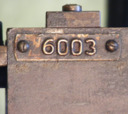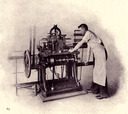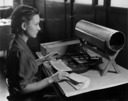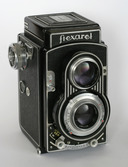The Barth type casting machine was developed in the late 1880s by Ernst Lietze and Henry Barth of the Cincinnati Type Foundry. It was not an original design, but was based closely on earlier European machines of Foucher. In addition to its use at the Cincinnati, it saw initial limited use in other type foundries in the United States (including at least 13 machines to foundries which were not a part of the 1892 ATF amalgamation). After the amalgamation of American Type Founders (ATF) in 1892, it spread to the various constituent foundries of the firm. After the consolidation of the ATF manufacturing foundries into a single central plant in New Jersey it became the best known of the three kinds of type casting machines used at ATF (which include many different kinds of "pivotal" (aka "Bruce") type casters, the Ziegler-patent casters for spaces and quads, and the Barths). It was not sold by ATF to other American foundries, but it was exported by them and used on an extremely limited basis by some foundries in Europe (including Stephenson Blake in the 1930s). However, it is now primarily associated with its major role at ATF.
In addition to being an extraordinary engineering object in its own right, from a historical perspective the Barth Type Caster is one of the most important type casting machines ever made. It is often spoken of - and not without reason - with almost mythological awe.
In 2014, I was lucky enough to be able to acquire a Barth type caster: a No. 3 1/2 machine, equipped with a 60 point mold. My thanks to Gregory Jackson Walters (1953-2022), without whom this would have been impossible.
Initially I planned to approach this type caster as an ordinary machine rebuilding project, as is still the standard practice in this field. Additionally, I planned (and still intend) to document its operation for the first time. The operation of the Barth has been passed down as in an oral tradition for over a century, but that direct line is in danger of being lost.
However, the goals of my Barth Project changed soon after I began serious work on the machine when it became apparent to me that it was an ethical imperative to bring the philosophy and techniques of conservation, and in particular "restorative conservation," to this machine. Such ideas have heretofore been absent from, even alien to, all work with typecasting machinery. As a result, this project has expanded to become an initial case study in how to apply these ideas and techniques to a representative piece of old heavy industrial machinery.
Beyond all of this, however, it is my own goal to add to the restorative conservation of this machine another set of layers of documentation which will effectively capture the machine as a living engineering object. This, also, expands the relevance of this project from being just the restorative conservation of an individual machine to being a case study in full engineering rediscovery.
For a detailed discussion of the goals of this project, its context in prior practices in this field, and my hope to expand the scope of how we look at old machines, see the Notebook below on the Goals and Guidelines of this project.
For those too busy to read that, here is an abbreviated summary:
This present set of "Notebooks" collects in one location all of the information specific to this and other Barths, and it links to relevant Notebooks elsewhere on CircuitousRoot. After the Notebook on the Goals and Guidelines of this project, I'll present an informal Journal of experiences. Following that are the more formal Reports, intended to capture all of the information necessary for a conservator or curator. After that comes a large collection of information of all kinds presenting my research into this machine and the results of this project. These sections duplicate all information in the Reports, but present it in greater detail with all available backing information.
This Barth project is also a case study in my general attempts at the Reverse Engineering of Big Old Machines.

Goals and Guidelines
The goals of this 60 Point Barth Project and the professional guidelines and industrial standards referenced by it. This includes a discussion of the prior state of affairs in the continued use of old typecasting machinery, a statement of the necessity of applying the ideas and techniques of conservation and restorative conservation to this machine, and a proposal for extending the scope of analysis of this machine, (and by extension of other mechanical artifacts) to a more complete reconstruction of their entire engineering state. In effect, I propose that while conserving this particular machine in accordance with all modern accepted practices, we also "run history backwards" to allow us to understand in detail every engineering aspect of this machine - and that we do this not from the perspective of the social historian, but from the perspective of the engineer, machinist, and machine operator.

A Barth Journal
Acquiring the only surviving 60pt Barth type caster; its restorative conservation and return to service.

History
[The Foucher Type Caster.] The Barth Type Caster Before ATF. ATF and Early Barth. [Sales Abroad by ATF.] [The Barth Type Caster After ATF.] A Census of Barth Type Casters. Other Casters at ATF.

Galleries of Images
From the literature. From photographs. Links to photographs and videos online. The intent here is to collect or to reference every known published image of a Barth type caster.

Preliminary Warnings for the Unwary
[NOT DONE] It is perhaps a natural instinct when approaching an unfamiliar but interesting machine to mess about with anything on it that moves. Do not do this. It is possible to injure yourself and damage the machine. This Notebook addresses simple issues of when it is and is not safe (for you and/or the machine) to cycle it and to swing the pot back. It also points out parts of the machine which are spring-loaded and which can move even when the machine is not under power.

Installation and Setup
[NOT DONE] Rigging and moving (incl. rigging drawing). Placement and services (incl. floor plan). Auxiliary equipment and tools.

Operator's Manual
[NOT DONE (just one section on machine paperwork online so far]
[Naming the parts of the machine.] [Lubrication.] Paperwork (Matrix Font Form, [Casting Logs]).

Technical Drawings & CAD Models
With an emphasis on the Size No. 3 1/2 60 point machine, but including drawings for any size machine.

Data and Tables
ATF constituent foundry designations. Mold identification. Type height.

Notes and Photographs
All of my photographs and un-edited notes (scrawls) from my work on the 60pt Barth.
All portions of this document not noted otherwise are Copyright © 2008, 2014-2016, 2018, 2022 by David M. MacMillan.
Circuitous Root is a Registered Trademark of David M. MacMillan.
This work is licensed under the Creative Commons "Attribution - ShareAlike" license, version 4.0 International. See http://creativecommons.org/licenses/by-sa/4.0/ for its terms.
Presented originally by Circuitous Root®